Statistical Analysis: Cancer, Age, and Gender Relationship Report
VerifiedAdded on 2022/08/31
|16
|3269
|20
Report
AI Summary
This report presents a statistical analysis of the relationship between cancer, age, and gender. The study utilizes a dataset with cancer as the dependent variable and age and gender as independent variables. The research begins with an introduction to the global cancer problem, supported by literature from various studies and the WHO. The study formulates research questions and hypotheses to explore the correlation between cancer, age, and gender. The methodology involves descriptive statistics, including frequency distributions and percentages, along with inferential statistics, such as chi-square tests and independent sample t-tests. The results section presents descriptive statistics for age, gender, and cancer variables, followed by inferential statistics. Crosstabs are used to check the proportions of variables. The study finds no statistically significant association between cancer and gender, or cancer and age, failing to reject the null hypotheses. The report concludes with an annotated bibliography of the sources used, providing a comprehensive overview of the research and its findings.
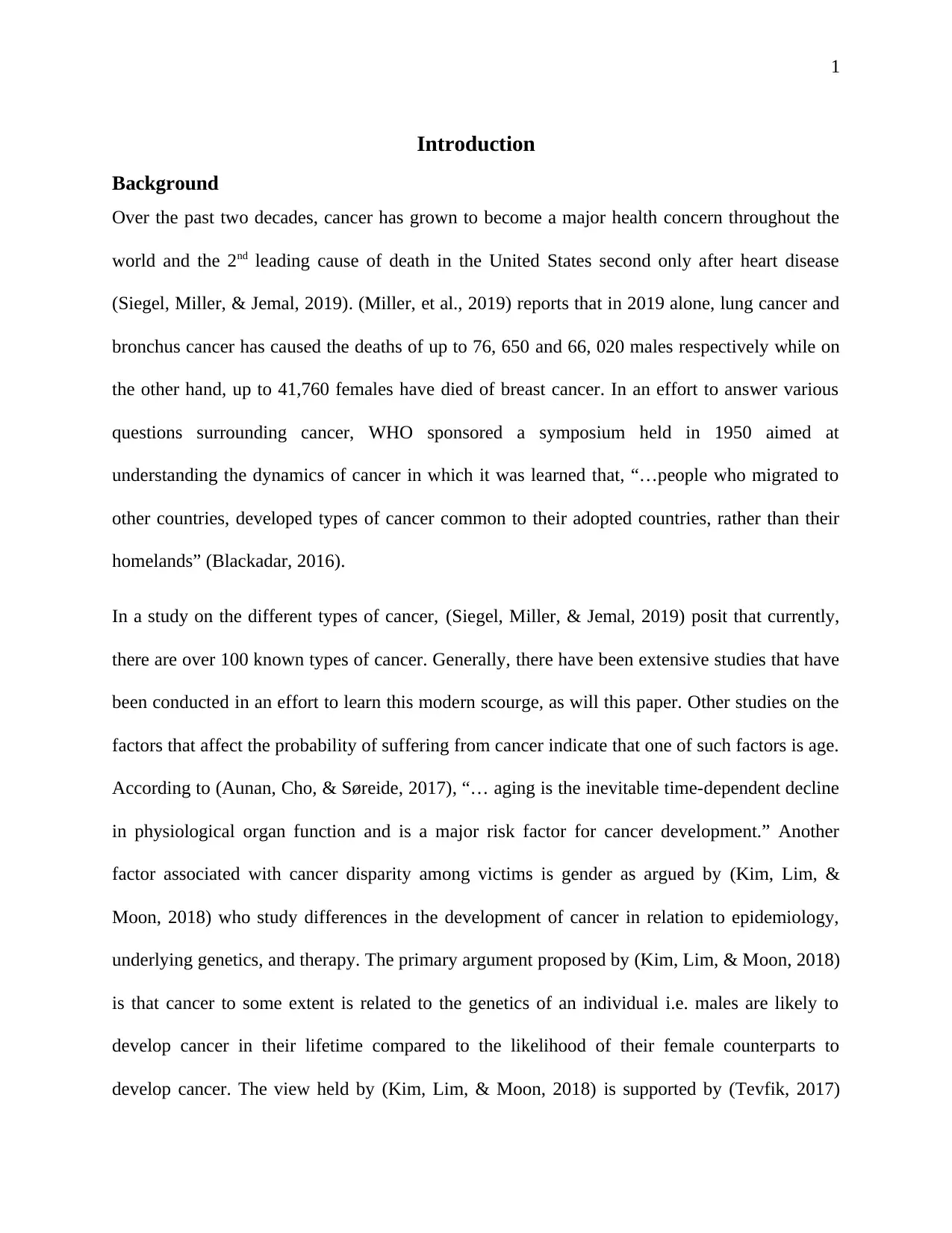
1
Introduction
Background
Over the past two decades, cancer has grown to become a major health concern throughout the
world and the 2nd leading cause of death in the United States second only after heart disease
(Siegel, Miller, & Jemal, 2019). (Miller, et al., 2019) reports that in 2019 alone, lung cancer and
bronchus cancer has caused the deaths of up to 76, 650 and 66, 020 males respectively while on
the other hand, up to 41,760 females have died of breast cancer. In an effort to answer various
questions surrounding cancer, WHO sponsored a symposium held in 1950 aimed at
understanding the dynamics of cancer in which it was learned that, “…people who migrated to
other countries, developed types of cancer common to their adopted countries, rather than their
homelands” (Blackadar, 2016).
In a study on the different types of cancer, (Siegel, Miller, & Jemal, 2019) posit that currently,
there are over 100 known types of cancer. Generally, there have been extensive studies that have
been conducted in an effort to learn this modern scourge, as will this paper. Other studies on the
factors that affect the probability of suffering from cancer indicate that one of such factors is age.
According to (Aunan, Cho, & Søreide, 2017), “… aging is the inevitable time-dependent decline
in physiological organ function and is a major risk factor for cancer development.” Another
factor associated with cancer disparity among victims is gender as argued by (Kim, Lim, &
Moon, 2018) who study differences in the development of cancer in relation to epidemiology,
underlying genetics, and therapy. The primary argument proposed by (Kim, Lim, & Moon, 2018)
is that cancer to some extent is related to the genetics of an individual i.e. males are likely to
develop cancer in their lifetime compared to the likelihood of their female counterparts to
develop cancer. The view held by (Kim, Lim, & Moon, 2018) is supported by (Tevfik, 2017)
Introduction
Background
Over the past two decades, cancer has grown to become a major health concern throughout the
world and the 2nd leading cause of death in the United States second only after heart disease
(Siegel, Miller, & Jemal, 2019). (Miller, et al., 2019) reports that in 2019 alone, lung cancer and
bronchus cancer has caused the deaths of up to 76, 650 and 66, 020 males respectively while on
the other hand, up to 41,760 females have died of breast cancer. In an effort to answer various
questions surrounding cancer, WHO sponsored a symposium held in 1950 aimed at
understanding the dynamics of cancer in which it was learned that, “…people who migrated to
other countries, developed types of cancer common to their adopted countries, rather than their
homelands” (Blackadar, 2016).
In a study on the different types of cancer, (Siegel, Miller, & Jemal, 2019) posit that currently,
there are over 100 known types of cancer. Generally, there have been extensive studies that have
been conducted in an effort to learn this modern scourge, as will this paper. Other studies on the
factors that affect the probability of suffering from cancer indicate that one of such factors is age.
According to (Aunan, Cho, & Søreide, 2017), “… aging is the inevitable time-dependent decline
in physiological organ function and is a major risk factor for cancer development.” Another
factor associated with cancer disparity among victims is gender as argued by (Kim, Lim, &
Moon, 2018) who study differences in the development of cancer in relation to epidemiology,
underlying genetics, and therapy. The primary argument proposed by (Kim, Lim, & Moon, 2018)
is that cancer to some extent is related to the genetics of an individual i.e. males are likely to
develop cancer in their lifetime compared to the likelihood of their female counterparts to
develop cancer. The view held by (Kim, Lim, & Moon, 2018) is supported by (Tevfik, 2017)
Paraphrase This Document
Need a fresh take? Get an instant paraphrase of this document with our AI Paraphraser
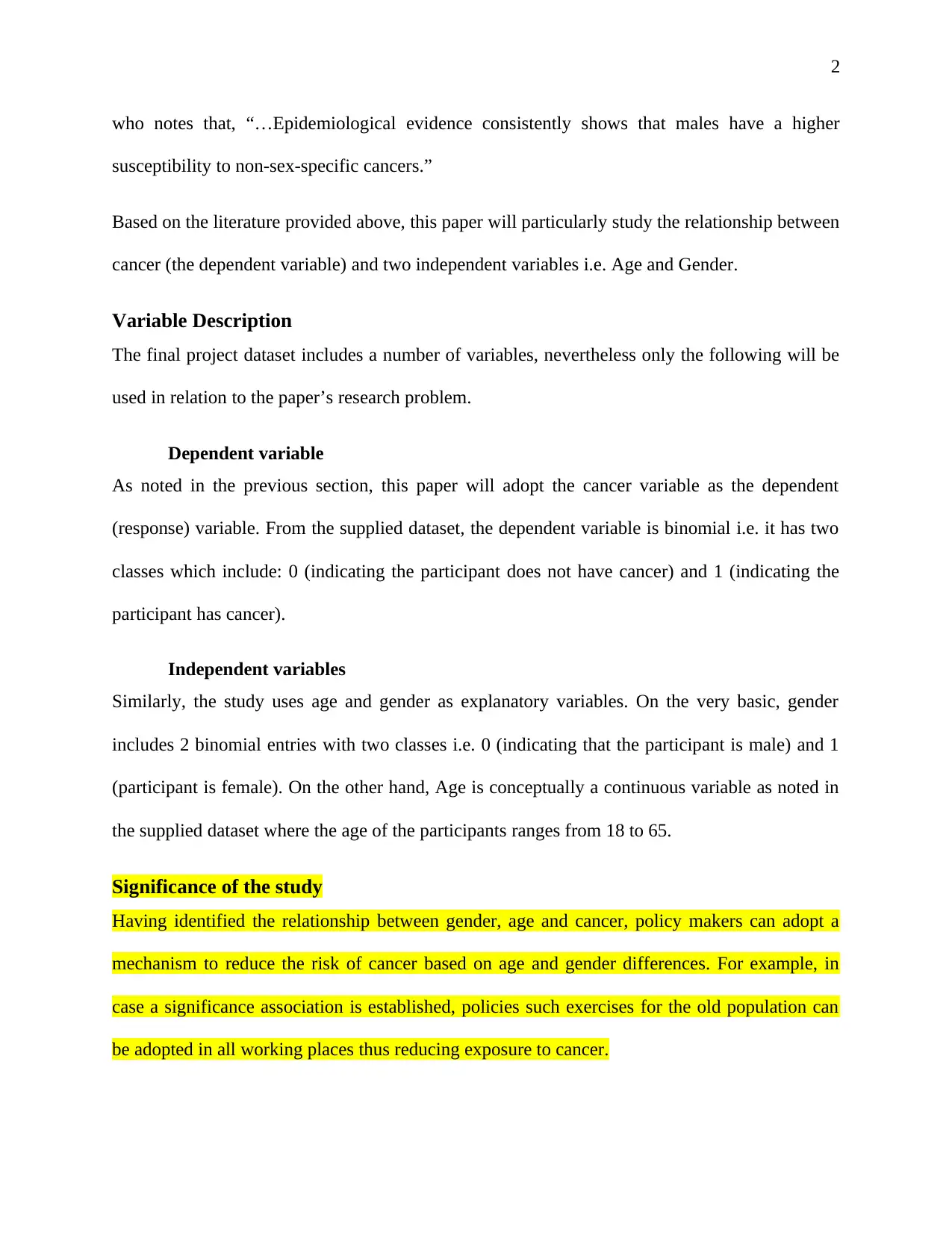
2
who notes that, “…Epidemiological evidence consistently shows that males have a higher
susceptibility to non-sex-specific cancers.”
Based on the literature provided above, this paper will particularly study the relationship between
cancer (the dependent variable) and two independent variables i.e. Age and Gender.
Variable Description
The final project dataset includes a number of variables, nevertheless only the following will be
used in relation to the paper’s research problem.
Dependent variable
As noted in the previous section, this paper will adopt the cancer variable as the dependent
(response) variable. From the supplied dataset, the dependent variable is binomial i.e. it has two
classes which include: 0 (indicating the participant does not have cancer) and 1 (indicating the
participant has cancer).
Independent variables
Similarly, the study uses age and gender as explanatory variables. On the very basic, gender
includes 2 binomial entries with two classes i.e. 0 (indicating that the participant is male) and 1
(participant is female). On the other hand, Age is conceptually a continuous variable as noted in
the supplied dataset where the age of the participants ranges from 18 to 65.
Significance of the study
Having identified the relationship between gender, age and cancer, policy makers can adopt a
mechanism to reduce the risk of cancer based on age and gender differences. For example, in
case a significance association is established, policies such exercises for the old population can
be adopted in all working places thus reducing exposure to cancer.
who notes that, “…Epidemiological evidence consistently shows that males have a higher
susceptibility to non-sex-specific cancers.”
Based on the literature provided above, this paper will particularly study the relationship between
cancer (the dependent variable) and two independent variables i.e. Age and Gender.
Variable Description
The final project dataset includes a number of variables, nevertheless only the following will be
used in relation to the paper’s research problem.
Dependent variable
As noted in the previous section, this paper will adopt the cancer variable as the dependent
(response) variable. From the supplied dataset, the dependent variable is binomial i.e. it has two
classes which include: 0 (indicating the participant does not have cancer) and 1 (indicating the
participant has cancer).
Independent variables
Similarly, the study uses age and gender as explanatory variables. On the very basic, gender
includes 2 binomial entries with two classes i.e. 0 (indicating that the participant is male) and 1
(participant is female). On the other hand, Age is conceptually a continuous variable as noted in
the supplied dataset where the age of the participants ranges from 18 to 65.
Significance of the study
Having identified the relationship between gender, age and cancer, policy makers can adopt a
mechanism to reduce the risk of cancer based on age and gender differences. For example, in
case a significance association is established, policies such exercises for the old population can
be adopted in all working places thus reducing exposure to cancer.
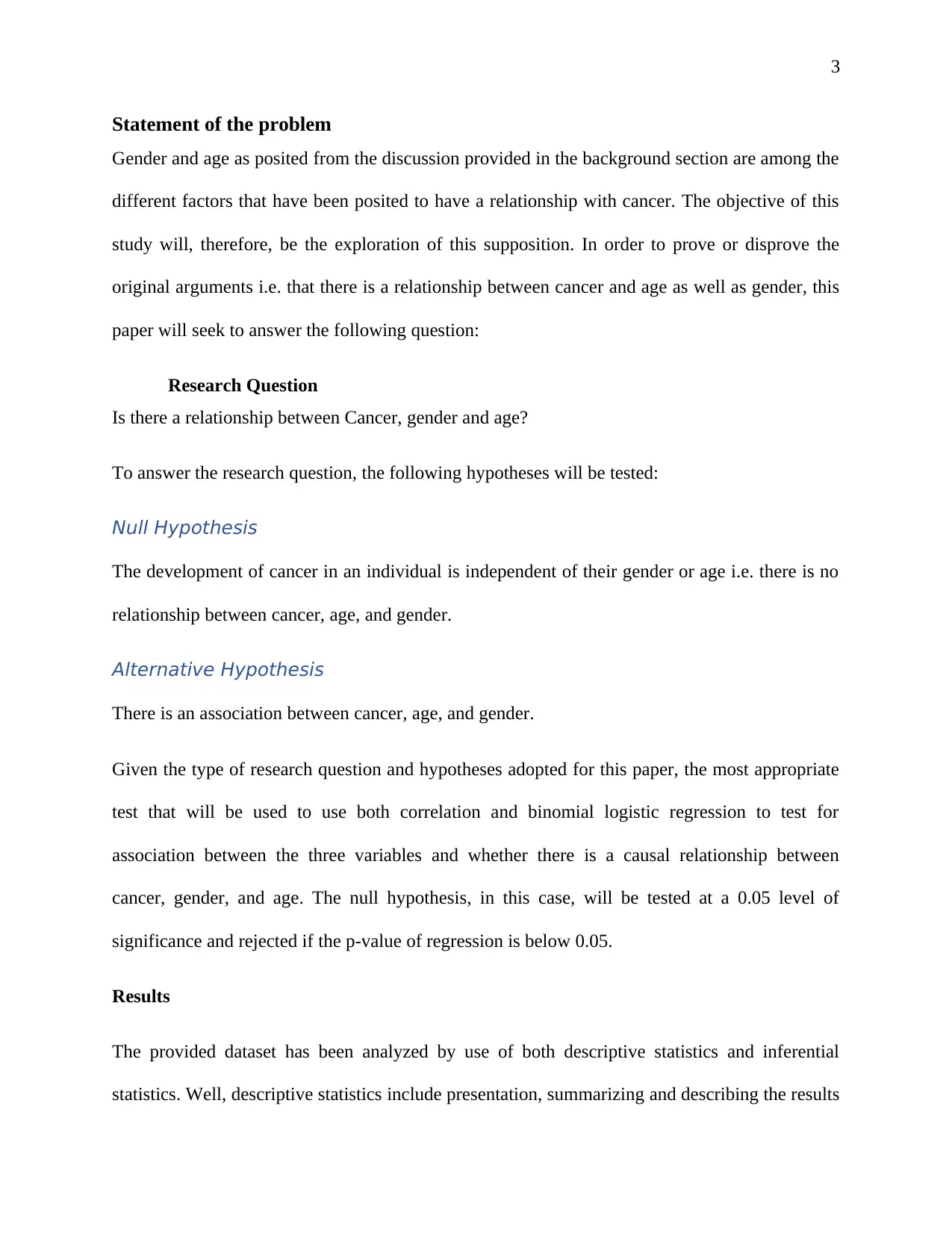
3
Statement of the problem
Gender and age as posited from the discussion provided in the background section are among the
different factors that have been posited to have a relationship with cancer. The objective of this
study will, therefore, be the exploration of this supposition. In order to prove or disprove the
original arguments i.e. that there is a relationship between cancer and age as well as gender, this
paper will seek to answer the following question:
Research Question
Is there a relationship between Cancer, gender and age?
To answer the research question, the following hypotheses will be tested:
Null Hypothesis
The development of cancer in an individual is independent of their gender or age i.e. there is no
relationship between cancer, age, and gender.
Alternative Hypothesis
There is an association between cancer, age, and gender.
Given the type of research question and hypotheses adopted for this paper, the most appropriate
test that will be used to use both correlation and binomial logistic regression to test for
association between the three variables and whether there is a causal relationship between
cancer, gender, and age. The null hypothesis, in this case, will be tested at a 0.05 level of
significance and rejected if the p-value of regression is below 0.05.
Results
The provided dataset has been analyzed by use of both descriptive statistics and inferential
statistics. Well, descriptive statistics include presentation, summarizing and describing the results
Statement of the problem
Gender and age as posited from the discussion provided in the background section are among the
different factors that have been posited to have a relationship with cancer. The objective of this
study will, therefore, be the exploration of this supposition. In order to prove or disprove the
original arguments i.e. that there is a relationship between cancer and age as well as gender, this
paper will seek to answer the following question:
Research Question
Is there a relationship between Cancer, gender and age?
To answer the research question, the following hypotheses will be tested:
Null Hypothesis
The development of cancer in an individual is independent of their gender or age i.e. there is no
relationship between cancer, age, and gender.
Alternative Hypothesis
There is an association between cancer, age, and gender.
Given the type of research question and hypotheses adopted for this paper, the most appropriate
test that will be used to use both correlation and binomial logistic regression to test for
association between the three variables and whether there is a causal relationship between
cancer, gender, and age. The null hypothesis, in this case, will be tested at a 0.05 level of
significance and rejected if the p-value of regression is below 0.05.
Results
The provided dataset has been analyzed by use of both descriptive statistics and inferential
statistics. Well, descriptive statistics include presentation, summarizing and describing the results
⊘ This is a preview!⊘
Do you want full access?
Subscribe today to unlock all pages.

Trusted by 1+ million students worldwide
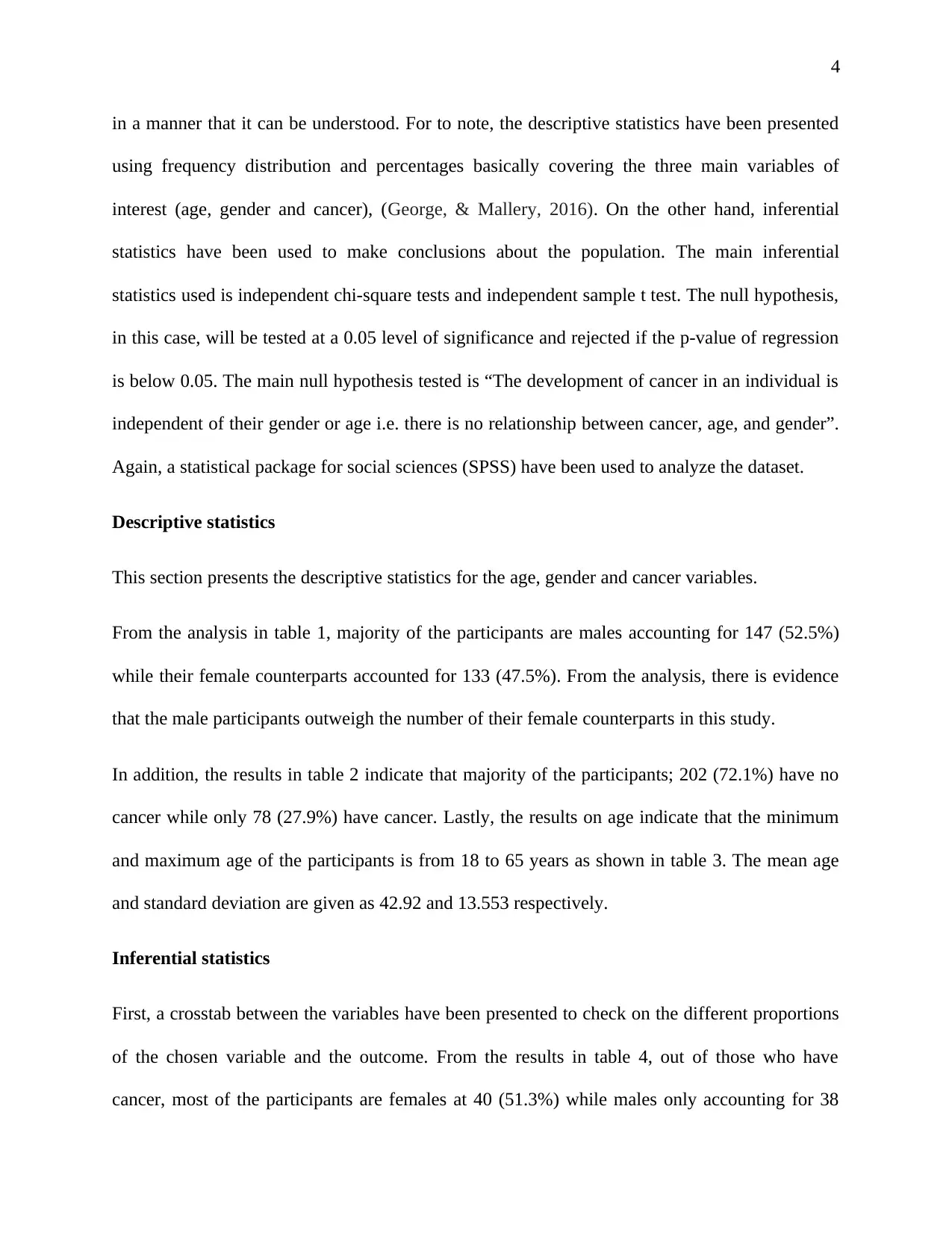
4
in a manner that it can be understood. For to note, the descriptive statistics have been presented
using frequency distribution and percentages basically covering the three main variables of
interest (age, gender and cancer), (George, & Mallery, 2016). On the other hand, inferential
statistics have been used to make conclusions about the population. The main inferential
statistics used is independent chi-square tests and independent sample t test. The null hypothesis,
in this case, will be tested at a 0.05 level of significance and rejected if the p-value of regression
is below 0.05. The main null hypothesis tested is “The development of cancer in an individual is
independent of their gender or age i.e. there is no relationship between cancer, age, and gender”.
Again, a statistical package for social sciences (SPSS) have been used to analyze the dataset.
Descriptive statistics
This section presents the descriptive statistics for the age, gender and cancer variables.
From the analysis in table 1, majority of the participants are males accounting for 147 (52.5%)
while their female counterparts accounted for 133 (47.5%). From the analysis, there is evidence
that the male participants outweigh the number of their female counterparts in this study.
In addition, the results in table 2 indicate that majority of the participants; 202 (72.1%) have no
cancer while only 78 (27.9%) have cancer. Lastly, the results on age indicate that the minimum
and maximum age of the participants is from 18 to 65 years as shown in table 3. The mean age
and standard deviation are given as 42.92 and 13.553 respectively.
Inferential statistics
First, a crosstab between the variables have been presented to check on the different proportions
of the chosen variable and the outcome. From the results in table 4, out of those who have
cancer, most of the participants are females at 40 (51.3%) while males only accounting for 38
in a manner that it can be understood. For to note, the descriptive statistics have been presented
using frequency distribution and percentages basically covering the three main variables of
interest (age, gender and cancer), (George, & Mallery, 2016). On the other hand, inferential
statistics have been used to make conclusions about the population. The main inferential
statistics used is independent chi-square tests and independent sample t test. The null hypothesis,
in this case, will be tested at a 0.05 level of significance and rejected if the p-value of regression
is below 0.05. The main null hypothesis tested is “The development of cancer in an individual is
independent of their gender or age i.e. there is no relationship between cancer, age, and gender”.
Again, a statistical package for social sciences (SPSS) have been used to analyze the dataset.
Descriptive statistics
This section presents the descriptive statistics for the age, gender and cancer variables.
From the analysis in table 1, majority of the participants are males accounting for 147 (52.5%)
while their female counterparts accounted for 133 (47.5%). From the analysis, there is evidence
that the male participants outweigh the number of their female counterparts in this study.
In addition, the results in table 2 indicate that majority of the participants; 202 (72.1%) have no
cancer while only 78 (27.9%) have cancer. Lastly, the results on age indicate that the minimum
and maximum age of the participants is from 18 to 65 years as shown in table 3. The mean age
and standard deviation are given as 42.92 and 13.553 respectively.
Inferential statistics
First, a crosstab between the variables have been presented to check on the different proportions
of the chosen variable and the outcome. From the results in table 4, out of those who have
cancer, most of the participants are females at 40 (51.3%) while males only accounting for 38
Paraphrase This Document
Need a fresh take? Get an instant paraphrase of this document with our AI Paraphraser
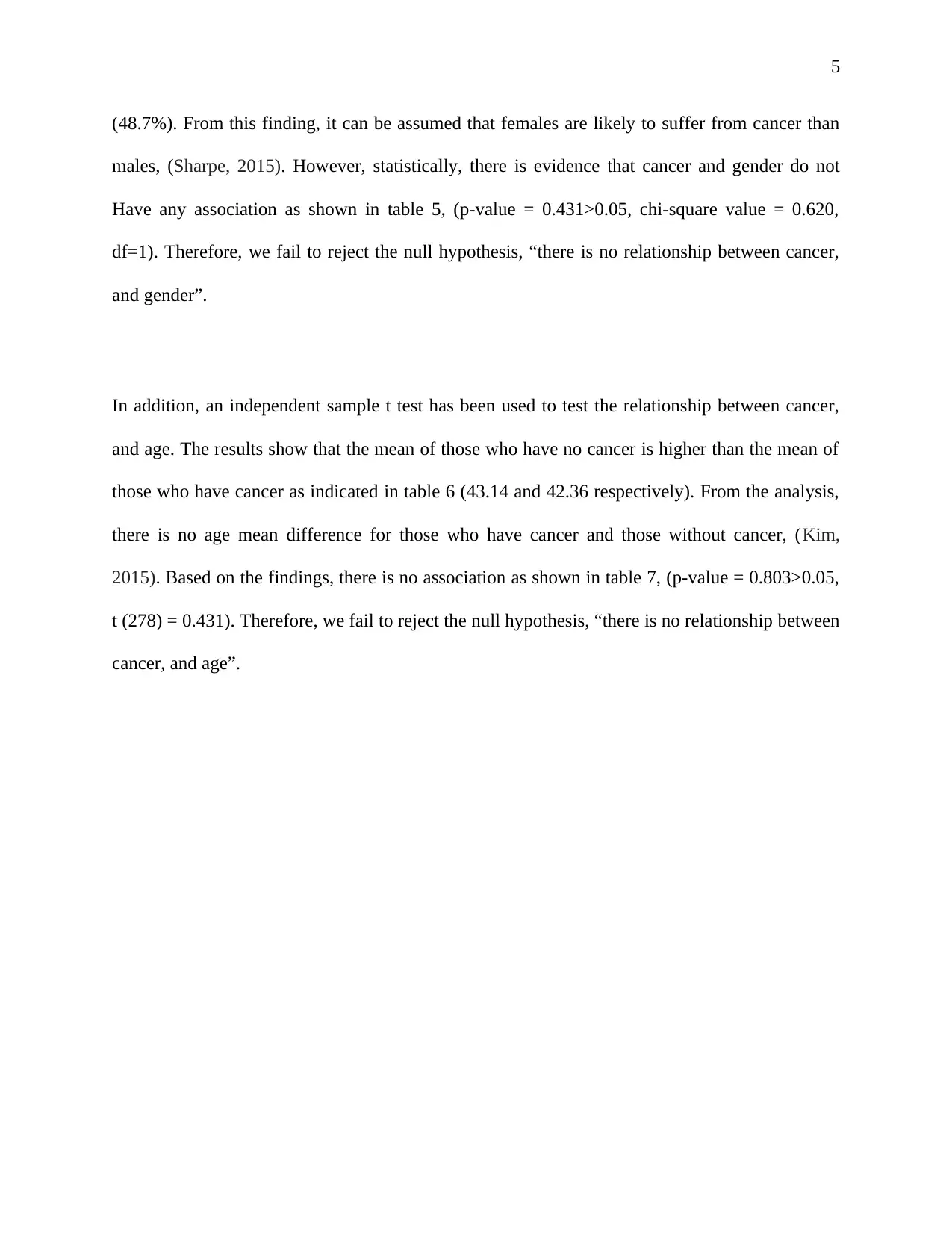
5
(48.7%). From this finding, it can be assumed that females are likely to suffer from cancer than
males, (Sharpe, 2015). However, statistically, there is evidence that cancer and gender do not
Have any association as shown in table 5, (p-value = 0.431>0.05, chi-square value = 0.620,
df=1). Therefore, we fail to reject the null hypothesis, “there is no relationship between cancer,
and gender”.
In addition, an independent sample t test has been used to test the relationship between cancer,
and age. The results show that the mean of those who have no cancer is higher than the mean of
those who have cancer as indicated in table 6 (43.14 and 42.36 respectively). From the analysis,
there is no age mean difference for those who have cancer and those without cancer, (Kim,
2015). Based on the findings, there is no association as shown in table 7, (p-value = 0.803>0.05,
t (278) = 0.431). Therefore, we fail to reject the null hypothesis, “there is no relationship between
cancer, and age”.
(48.7%). From this finding, it can be assumed that females are likely to suffer from cancer than
males, (Sharpe, 2015). However, statistically, there is evidence that cancer and gender do not
Have any association as shown in table 5, (p-value = 0.431>0.05, chi-square value = 0.620,
df=1). Therefore, we fail to reject the null hypothesis, “there is no relationship between cancer,
and gender”.
In addition, an independent sample t test has been used to test the relationship between cancer,
and age. The results show that the mean of those who have no cancer is higher than the mean of
those who have cancer as indicated in table 6 (43.14 and 42.36 respectively). From the analysis,
there is no age mean difference for those who have cancer and those without cancer, (Kim,
2015). Based on the findings, there is no association as shown in table 7, (p-value = 0.803>0.05,
t (278) = 0.431). Therefore, we fail to reject the null hypothesis, “there is no relationship between
cancer, and age”.
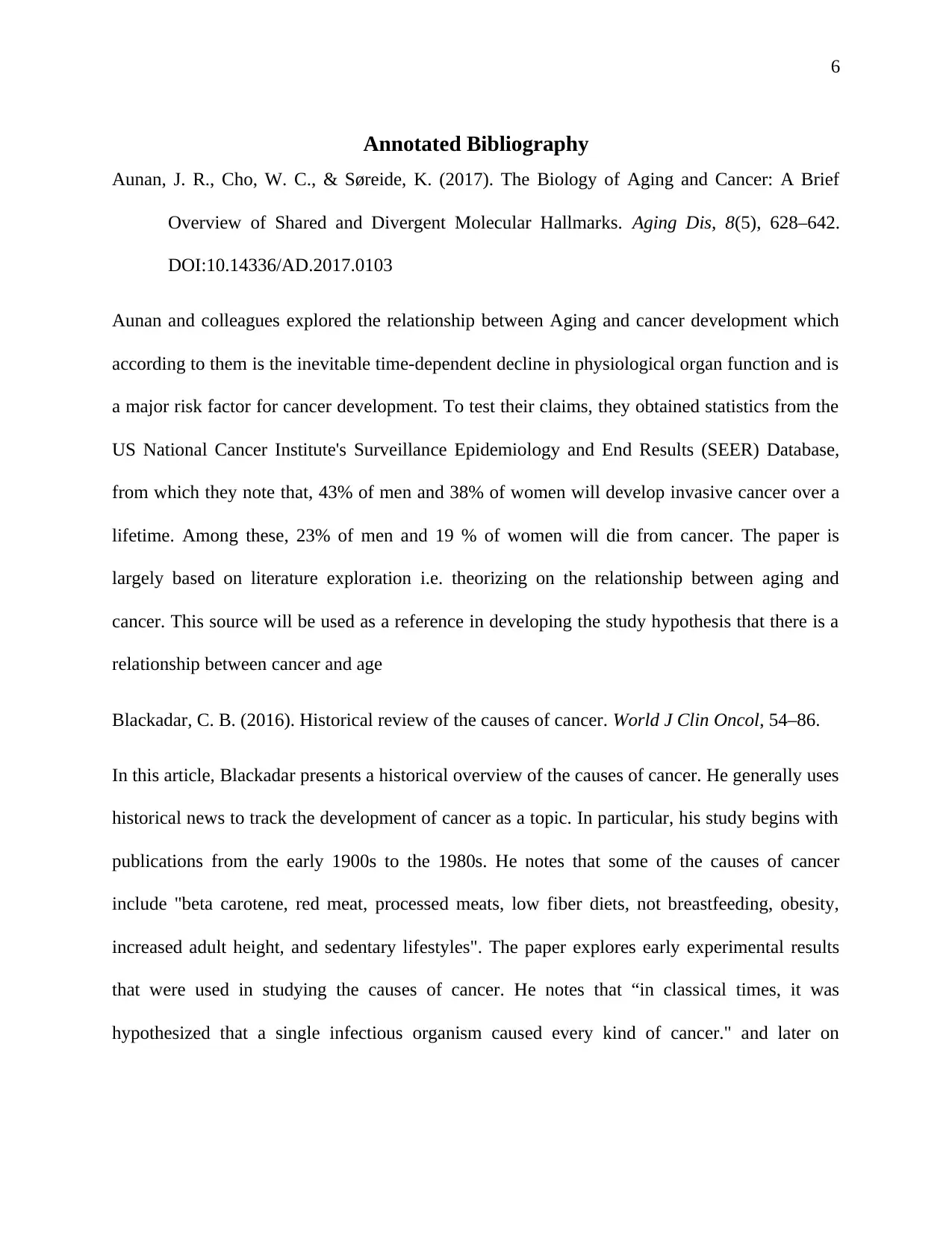
6
Annotated Bibliography
Aunan, J. R., Cho, W. C., & Søreide, K. (2017). The Biology of Aging and Cancer: A Brief
Overview of Shared and Divergent Molecular Hallmarks. Aging Dis, 8(5), 628–642.
DOI:10.14336/AD.2017.0103
Aunan and colleagues explored the relationship between Aging and cancer development which
according to them is the inevitable time-dependent decline in physiological organ function and is
a major risk factor for cancer development. To test their claims, they obtained statistics from the
US National Cancer Institute's Surveillance Epidemiology and End Results (SEER) Database,
from which they note that, 43% of men and 38% of women will develop invasive cancer over a
lifetime. Among these, 23% of men and 19 % of women will die from cancer. The paper is
largely based on literature exploration i.e. theorizing on the relationship between aging and
cancer. This source will be used as a reference in developing the study hypothesis that there is a
relationship between cancer and age
Blackadar, C. B. (2016). Historical review of the causes of cancer. World J Clin Oncol, 54–86.
In this article, Blackadar presents a historical overview of the causes of cancer. He generally uses
historical news to track the development of cancer as a topic. In particular, his study begins with
publications from the early 1900s to the 1980s. He notes that some of the causes of cancer
include "beta carotene, red meat, processed meats, low fiber diets, not breastfeeding, obesity,
increased adult height, and sedentary lifestyles". The paper explores early experimental results
that were used in studying the causes of cancer. He notes that “in classical times, it was
hypothesized that a single infectious organism caused every kind of cancer." and later on
Annotated Bibliography
Aunan, J. R., Cho, W. C., & Søreide, K. (2017). The Biology of Aging and Cancer: A Brief
Overview of Shared and Divergent Molecular Hallmarks. Aging Dis, 8(5), 628–642.
DOI:10.14336/AD.2017.0103
Aunan and colleagues explored the relationship between Aging and cancer development which
according to them is the inevitable time-dependent decline in physiological organ function and is
a major risk factor for cancer development. To test their claims, they obtained statistics from the
US National Cancer Institute's Surveillance Epidemiology and End Results (SEER) Database,
from which they note that, 43% of men and 38% of women will develop invasive cancer over a
lifetime. Among these, 23% of men and 19 % of women will die from cancer. The paper is
largely based on literature exploration i.e. theorizing on the relationship between aging and
cancer. This source will be used as a reference in developing the study hypothesis that there is a
relationship between cancer and age
Blackadar, C. B. (2016). Historical review of the causes of cancer. World J Clin Oncol, 54–86.
In this article, Blackadar presents a historical overview of the causes of cancer. He generally uses
historical news to track the development of cancer as a topic. In particular, his study begins with
publications from the early 1900s to the 1980s. He notes that some of the causes of cancer
include "beta carotene, red meat, processed meats, low fiber diets, not breastfeeding, obesity,
increased adult height, and sedentary lifestyles". The paper explores early experimental results
that were used in studying the causes of cancer. He notes that “in classical times, it was
hypothesized that a single infectious organism caused every kind of cancer." and later on
⊘ This is a preview!⊘
Do you want full access?
Subscribe today to unlock all pages.

Trusted by 1+ million students worldwide
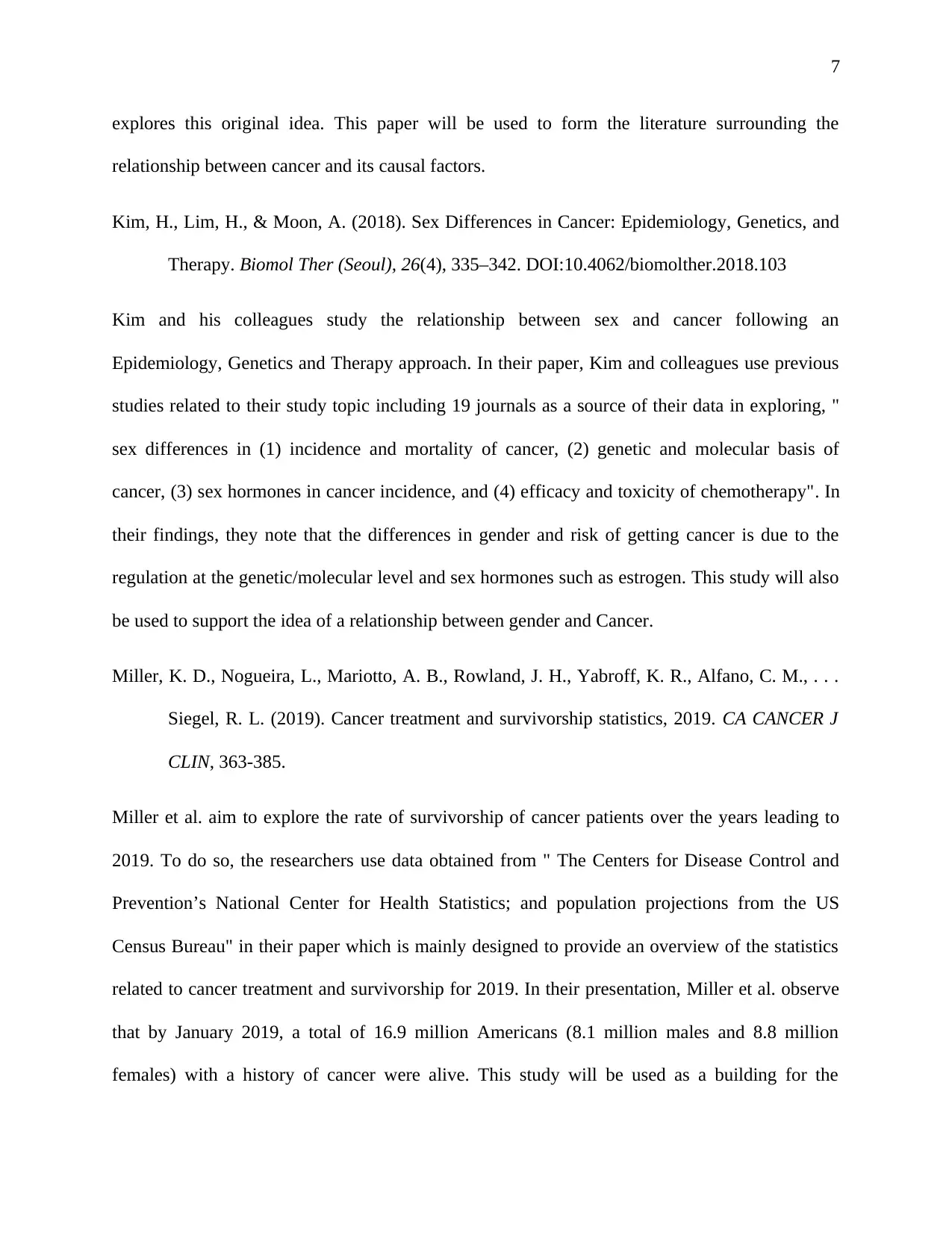
7
explores this original idea. This paper will be used to form the literature surrounding the
relationship between cancer and its causal factors.
Kim, H., Lim, H., & Moon, A. (2018). Sex Differences in Cancer: Epidemiology, Genetics, and
Therapy. Biomol Ther (Seoul), 26(4), 335–342. DOI:10.4062/biomolther.2018.103
Kim and his colleagues study the relationship between sex and cancer following an
Epidemiology, Genetics and Therapy approach. In their paper, Kim and colleagues use previous
studies related to their study topic including 19 journals as a source of their data in exploring, "
sex differences in (1) incidence and mortality of cancer, (2) genetic and molecular basis of
cancer, (3) sex hormones in cancer incidence, and (4) efficacy and toxicity of chemotherapy". In
their findings, they note that the differences in gender and risk of getting cancer is due to the
regulation at the genetic/molecular level and sex hormones such as estrogen. This study will also
be used to support the idea of a relationship between gender and Cancer.
Miller, K. D., Nogueira, L., Mariotto, A. B., Rowland, J. H., Yabroff, K. R., Alfano, C. M., . . .
Siegel, R. L. (2019). Cancer treatment and survivorship statistics, 2019. CA CANCER J
CLIN, 363-385.
Miller et al. aim to explore the rate of survivorship of cancer patients over the years leading to
2019. To do so, the researchers use data obtained from " The Centers for Disease Control and
Prevention’s National Center for Health Statistics; and population projections from the US
Census Bureau" in their paper which is mainly designed to provide an overview of the statistics
related to cancer treatment and survivorship for 2019. In their presentation, Miller et al. observe
that by January 2019, a total of 16.9 million Americans (8.1 million males and 8.8 million
females) with a history of cancer were alive. This study will be used as a building for the
explores this original idea. This paper will be used to form the literature surrounding the
relationship between cancer and its causal factors.
Kim, H., Lim, H., & Moon, A. (2018). Sex Differences in Cancer: Epidemiology, Genetics, and
Therapy. Biomol Ther (Seoul), 26(4), 335–342. DOI:10.4062/biomolther.2018.103
Kim and his colleagues study the relationship between sex and cancer following an
Epidemiology, Genetics and Therapy approach. In their paper, Kim and colleagues use previous
studies related to their study topic including 19 journals as a source of their data in exploring, "
sex differences in (1) incidence and mortality of cancer, (2) genetic and molecular basis of
cancer, (3) sex hormones in cancer incidence, and (4) efficacy and toxicity of chemotherapy". In
their findings, they note that the differences in gender and risk of getting cancer is due to the
regulation at the genetic/molecular level and sex hormones such as estrogen. This study will also
be used to support the idea of a relationship between gender and Cancer.
Miller, K. D., Nogueira, L., Mariotto, A. B., Rowland, J. H., Yabroff, K. R., Alfano, C. M., . . .
Siegel, R. L. (2019). Cancer treatment and survivorship statistics, 2019. CA CANCER J
CLIN, 363-385.
Miller et al. aim to explore the rate of survivorship of cancer patients over the years leading to
2019. To do so, the researchers use data obtained from " The Centers for Disease Control and
Prevention’s National Center for Health Statistics; and population projections from the US
Census Bureau" in their paper which is mainly designed to provide an overview of the statistics
related to cancer treatment and survivorship for 2019. In their presentation, Miller et al. observe
that by January 2019, a total of 16.9 million Americans (8.1 million males and 8.8 million
females) with a history of cancer were alive. This study will be used as a building for the
Paraphrase This Document
Need a fresh take? Get an instant paraphrase of this document with our AI Paraphraser
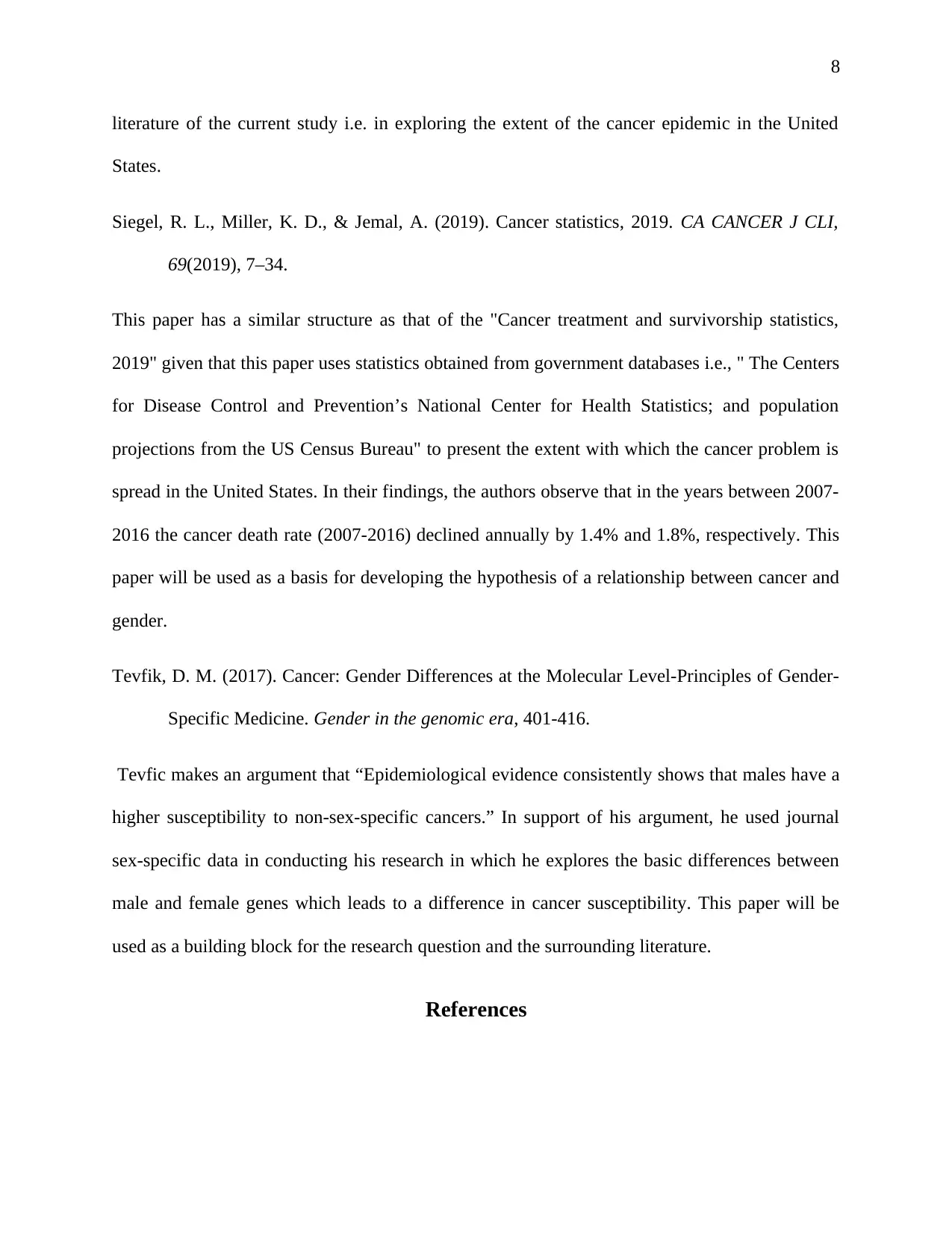
8
literature of the current study i.e. in exploring the extent of the cancer epidemic in the United
States.
Siegel, R. L., Miller, K. D., & Jemal, A. (2019). Cancer statistics, 2019. CA CANCER J CLI,
69(2019), 7–34.
This paper has a similar structure as that of the "Cancer treatment and survivorship statistics,
2019" given that this paper uses statistics obtained from government databases i.e., " The Centers
for Disease Control and Prevention’s National Center for Health Statistics; and population
projections from the US Census Bureau" to present the extent with which the cancer problem is
spread in the United States. In their findings, the authors observe that in the years between 2007-
2016 the cancer death rate (2007-2016) declined annually by 1.4% and 1.8%, respectively. This
paper will be used as a basis for developing the hypothesis of a relationship between cancer and
gender.
Tevfik, D. M. (2017). Cancer: Gender Differences at the Molecular Level-Principles of Gender-
Specific Medicine. Gender in the genomic era, 401-416.
Tevfic makes an argument that “Epidemiological evidence consistently shows that males have a
higher susceptibility to non-sex-specific cancers.” In support of his argument, he used journal
sex-specific data in conducting his research in which he explores the basic differences between
male and female genes which leads to a difference in cancer susceptibility. This paper will be
used as a building block for the research question and the surrounding literature.
References
literature of the current study i.e. in exploring the extent of the cancer epidemic in the United
States.
Siegel, R. L., Miller, K. D., & Jemal, A. (2019). Cancer statistics, 2019. CA CANCER J CLI,
69(2019), 7–34.
This paper has a similar structure as that of the "Cancer treatment and survivorship statistics,
2019" given that this paper uses statistics obtained from government databases i.e., " The Centers
for Disease Control and Prevention’s National Center for Health Statistics; and population
projections from the US Census Bureau" to present the extent with which the cancer problem is
spread in the United States. In their findings, the authors observe that in the years between 2007-
2016 the cancer death rate (2007-2016) declined annually by 1.4% and 1.8%, respectively. This
paper will be used as a basis for developing the hypothesis of a relationship between cancer and
gender.
Tevfik, D. M. (2017). Cancer: Gender Differences at the Molecular Level-Principles of Gender-
Specific Medicine. Gender in the genomic era, 401-416.
Tevfic makes an argument that “Epidemiological evidence consistently shows that males have a
higher susceptibility to non-sex-specific cancers.” In support of his argument, he used journal
sex-specific data in conducting his research in which he explores the basic differences between
male and female genes which leads to a difference in cancer susceptibility. This paper will be
used as a building block for the research question and the surrounding literature.
References
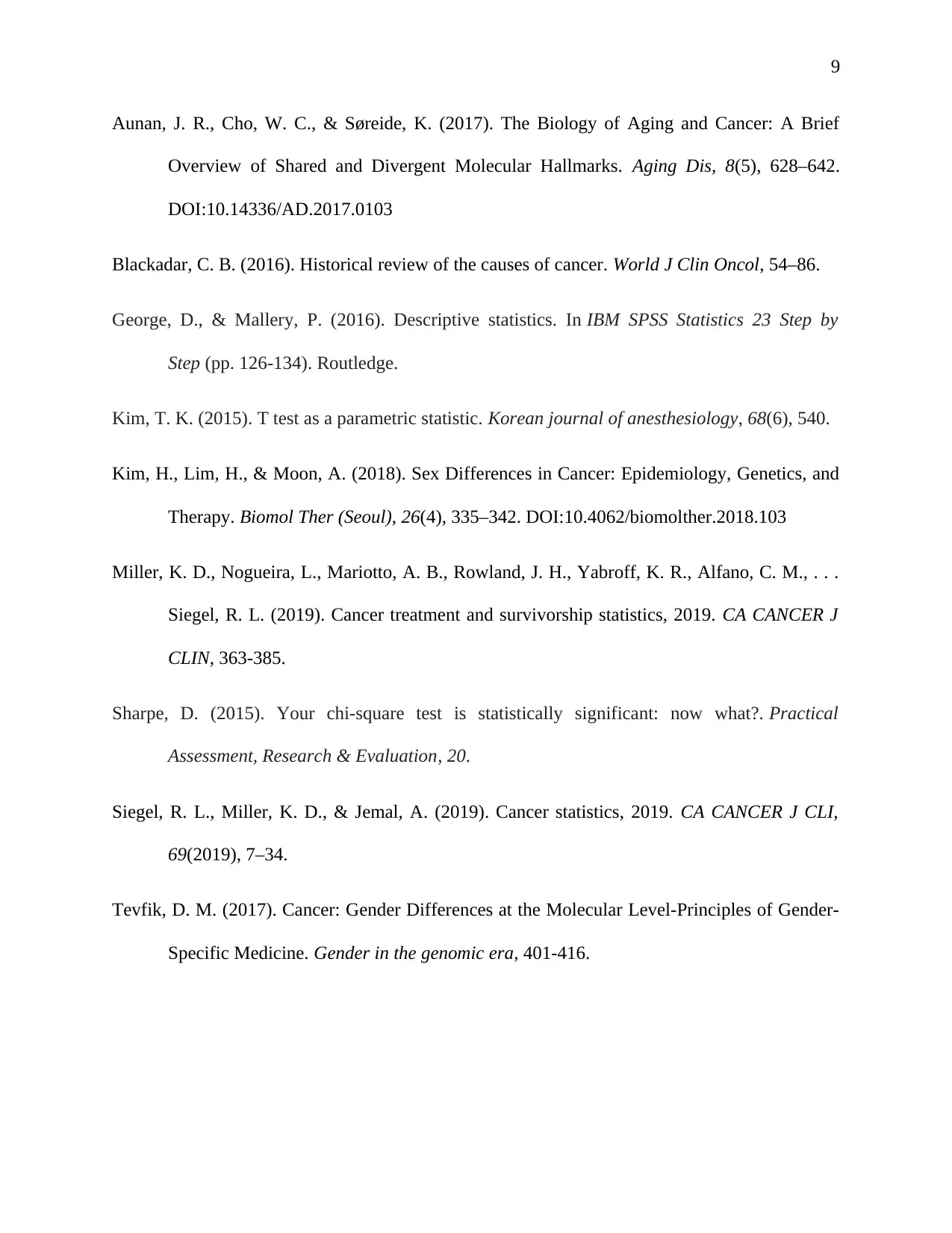
9
Aunan, J. R., Cho, W. C., & Søreide, K. (2017). The Biology of Aging and Cancer: A Brief
Overview of Shared and Divergent Molecular Hallmarks. Aging Dis, 8(5), 628–642.
DOI:10.14336/AD.2017.0103
Blackadar, C. B. (2016). Historical review of the causes of cancer. World J Clin Oncol, 54–86.
George, D., & Mallery, P. (2016). Descriptive statistics. In IBM SPSS Statistics 23 Step by
Step (pp. 126-134). Routledge.
Kim, T. K. (2015). T test as a parametric statistic. Korean journal of anesthesiology, 68(6), 540.
Kim, H., Lim, H., & Moon, A. (2018). Sex Differences in Cancer: Epidemiology, Genetics, and
Therapy. Biomol Ther (Seoul), 26(4), 335–342. DOI:10.4062/biomolther.2018.103
Miller, K. D., Nogueira, L., Mariotto, A. B., Rowland, J. H., Yabroff, K. R., Alfano, C. M., . . .
Siegel, R. L. (2019). Cancer treatment and survivorship statistics, 2019. CA CANCER J
CLIN, 363-385.
Sharpe, D. (2015). Your chi-square test is statistically significant: now what?. Practical
Assessment, Research & Evaluation, 20.
Siegel, R. L., Miller, K. D., & Jemal, A. (2019). Cancer statistics, 2019. CA CANCER J CLI,
69(2019), 7–34.
Tevfik, D. M. (2017). Cancer: Gender Differences at the Molecular Level-Principles of Gender-
Specific Medicine. Gender in the genomic era, 401-416.
Aunan, J. R., Cho, W. C., & Søreide, K. (2017). The Biology of Aging and Cancer: A Brief
Overview of Shared and Divergent Molecular Hallmarks. Aging Dis, 8(5), 628–642.
DOI:10.14336/AD.2017.0103
Blackadar, C. B. (2016). Historical review of the causes of cancer. World J Clin Oncol, 54–86.
George, D., & Mallery, P. (2016). Descriptive statistics. In IBM SPSS Statistics 23 Step by
Step (pp. 126-134). Routledge.
Kim, T. K. (2015). T test as a parametric statistic. Korean journal of anesthesiology, 68(6), 540.
Kim, H., Lim, H., & Moon, A. (2018). Sex Differences in Cancer: Epidemiology, Genetics, and
Therapy. Biomol Ther (Seoul), 26(4), 335–342. DOI:10.4062/biomolther.2018.103
Miller, K. D., Nogueira, L., Mariotto, A. B., Rowland, J. H., Yabroff, K. R., Alfano, C. M., . . .
Siegel, R. L. (2019). Cancer treatment and survivorship statistics, 2019. CA CANCER J
CLIN, 363-385.
Sharpe, D. (2015). Your chi-square test is statistically significant: now what?. Practical
Assessment, Research & Evaluation, 20.
Siegel, R. L., Miller, K. D., & Jemal, A. (2019). Cancer statistics, 2019. CA CANCER J CLI,
69(2019), 7–34.
Tevfik, D. M. (2017). Cancer: Gender Differences at the Molecular Level-Principles of Gender-
Specific Medicine. Gender in the genomic era, 401-416.
⊘ This is a preview!⊘
Do you want full access?
Subscribe today to unlock all pages.

Trusted by 1+ million students worldwide

10
Paraphrase This Document
Need a fresh take? Get an instant paraphrase of this document with our AI Paraphraser
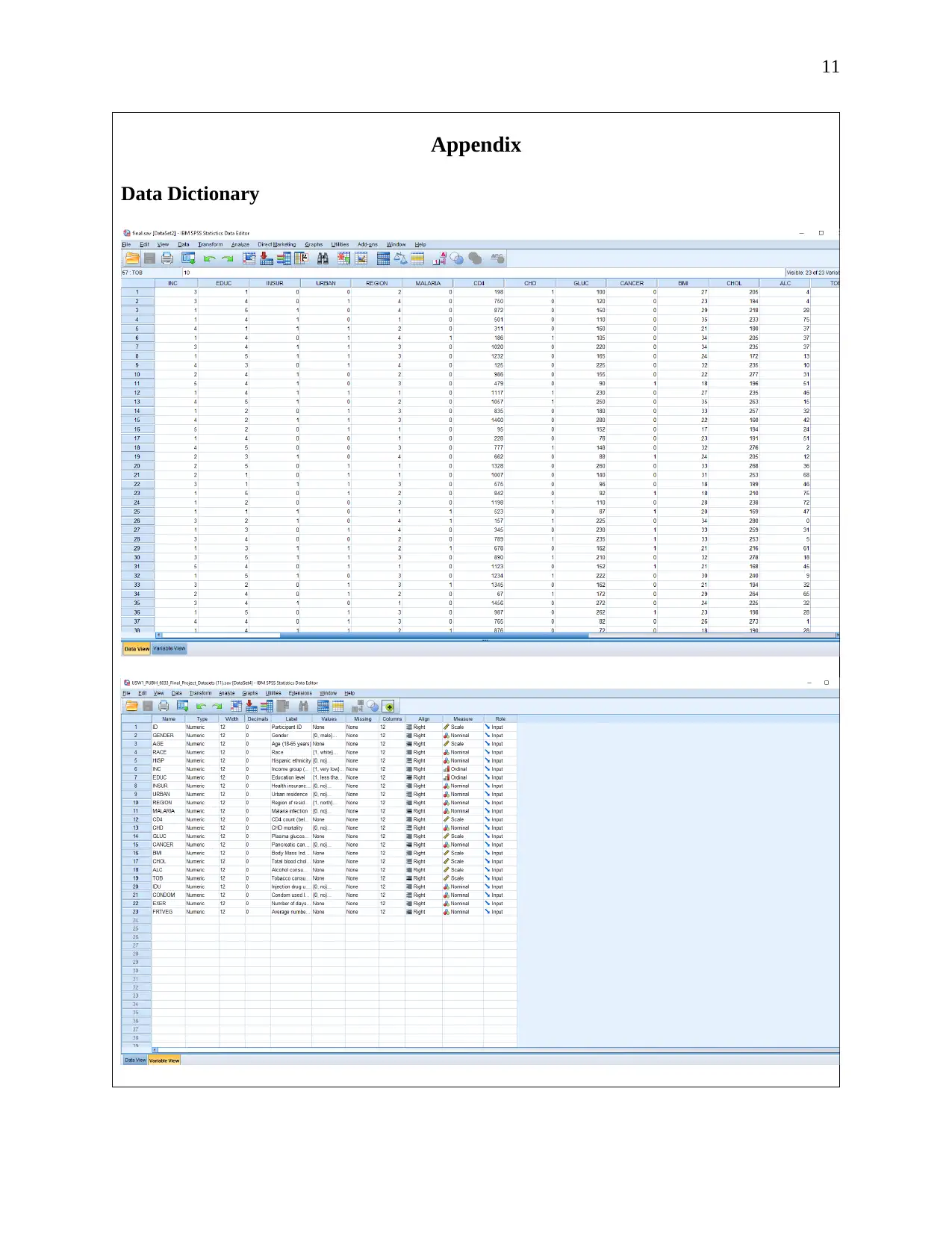
11
Appendix
Data Dictionary
Appendix
Data Dictionary
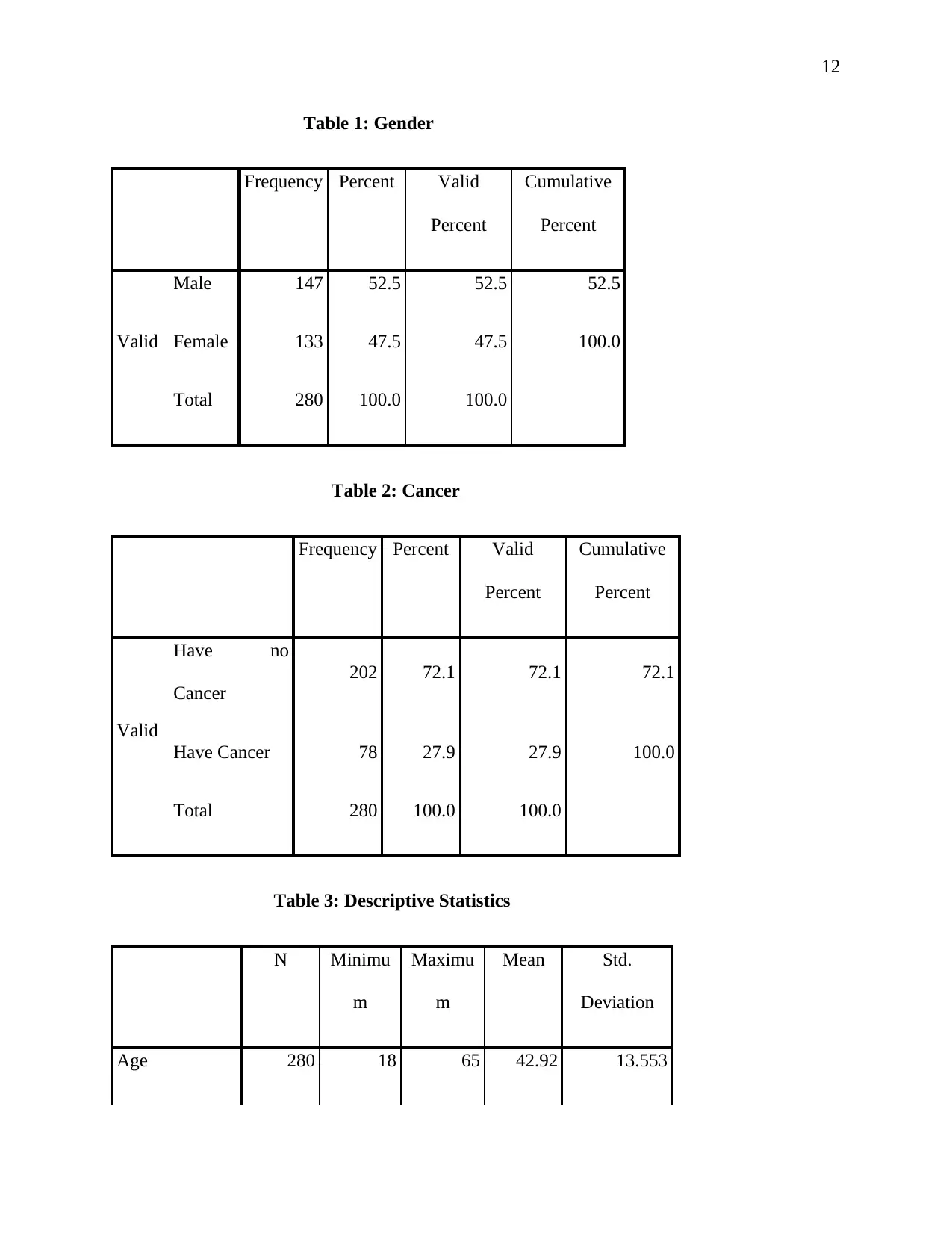
12
Table 1: Gender
Frequency Percent Valid
Percent
Cumulative
Percent
Valid
Male 147 52.5 52.5 52.5
Female 133 47.5 47.5 100.0
Total 280 100.0 100.0
Table 2: Cancer
Frequency Percent Valid
Percent
Cumulative
Percent
Valid
Have no
Cancer
202 72.1 72.1 72.1
Have Cancer 78 27.9 27.9 100.0
Total 280 100.0 100.0
Table 3: Descriptive Statistics
N Minimu
m
Maximu
m
Mean Std.
Deviation
Age 280 18 65 42.92 13.553
Table 1: Gender
Frequency Percent Valid
Percent
Cumulative
Percent
Valid
Male 147 52.5 52.5 52.5
Female 133 47.5 47.5 100.0
Total 280 100.0 100.0
Table 2: Cancer
Frequency Percent Valid
Percent
Cumulative
Percent
Valid
Have no
Cancer
202 72.1 72.1 72.1
Have Cancer 78 27.9 27.9 100.0
Total 280 100.0 100.0
Table 3: Descriptive Statistics
N Minimu
m
Maximu
m
Mean Std.
Deviation
Age 280 18 65 42.92 13.553
⊘ This is a preview!⊘
Do you want full access?
Subscribe today to unlock all pages.

Trusted by 1+ million students worldwide
1 out of 16
Your All-in-One AI-Powered Toolkit for Academic Success.
+13062052269
info@desklib.com
Available 24*7 on WhatsApp / Email
![[object Object]](/_next/static/media/star-bottom.7253800d.svg)
Unlock your academic potential
Copyright © 2020–2025 A2Z Services. All Rights Reserved. Developed and managed by ZUCOL.


